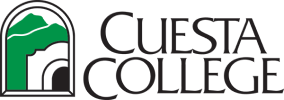
Program Summary
PHYSICS - Associate in Science
2023 - 2024, 2024 - 2025
The Cuesta College Physics Program engages students in the study of how the physical world works and why materials and objects behave the way they do. Physics students will learn to deduce the underlying principles and laws of nature, and apply those principles and laws to make estimations and predictions. The students completing this degree will have a proficiency in mechanics, fluids, thermodynamics, waves, electric and magnetic forces and fields, relativity, quantum physics, and atomic physics.
Career Opportunities
Required Courses (34 credits)
Units: 34.0
MATH 265A
CALCULUS I
5.0
MATH 265B
CALCULUS II
5.0
MATH 283
CALCULUS III: MULTIVARIABLE CALCULUS
5.0
MATH 287
ORDINARY DIFFERENTIAL EQUATIONS AND LINEAR ALGEBRA
5.0
PHYS 208A
PRINCIPLES OF PHYSICS 1
5.0
PHYS 208B
PRINCIPLES OF PHYSICS 2
5.0
PHYS 208C
MODERN PHYSICS
4.0
Total: 34.0
Program Outcomes
Apply statics and dynamics principles in order to solve problems involving:
a) motion of masses
b) electric forces
c) gravitational forces
d) magnetic forces
Administer a SLO self-survey during the last two weeks of class
Using a simple rubric and selected questions from quizzes and exams, determine the percentage of students who successfully the SLO’s for each class.
Utilize the concept of conservation of energy in problems involving:
a) motion of masses
b) electric fields and potentials
c) electric circuits
d) gravitational fields
Administer a SLO self-survey during the last two weeks of class
Using a simple rubric and selected questions from quizzes and exams, determine the percentage of students who successfully the SLO’s
Apply conservation of momentum and the relationship between impulse and momentum in order to solve problems involving:
a) general collisions
b) forces applied over time
c) perfectly elastic and inelastic collisions
Administer a SLO self-survey during the last two weeks of class Using a simple rubric and selected questions from quizzes and exams, determine the percentage of students who successfully the SLO’s
Analyze systems where quantum effects and relativity are appropriate.
Administer a SLO self-survey during the last two weeks of class.
Using a simple rubric and selected questions from quizzes and exams, determine the percentage of students who successfully the SLO’s
Safely perform laboratory experiments based on qualitative and quantitative analyses utilizing various apparatuses.
Administer a SLO self-survey during the last two weeks of class. Using a simple rubric and selected questions from quizzes and exams, determine the percentage of students who successfully the SLO’s